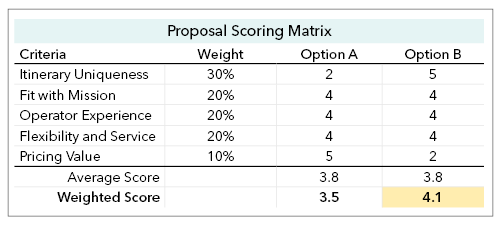5 Tips for Reviewing Travel Proposals
You’ve been proposed to. It’s actually not so flattering. As a travel planner, you’re getting proposed to all the time! Deciding on an itinerary and tour provider is a bit like getting hitched. You need to make the right decision as this is a long-term investment.
It’s tempting to just go with your gut—or stick with a main provider—but there’s a lot at stake. You want your group members to have a memorable and remarkable experience. Ordinary doesn’t cut it.
So you have work to do and you need to do it right. It’s important to start your search early, evaluating your options a year or two out. It’s typical to have more than one proposal for a destination and, depending on your organization, dozens of proposals at your fingertips.
Here are 5 helpful tips from experienced travel planners.
1. Stick to a process
Try to be consistent in how you evaluate each proposal. Use the same criteria (see below). Travel proposals generally contain similar information: a themed introduction, an itinerary, highlights, what’s included and what’s not, pricing and terms.
Items to consider in your process include the selection team, the timing in your calendar, the evaluation criteria, reading and scoring, and discussion. Even if you are the sole decision-maker, it’s helpful to have a colleague or two on your review team. You may even want to block out a half-day or more and retreat to a quiet place. This allows you to immerse yourself in the “romance” of the travel experience being proposed, not just the numbers.
2. Establish the evaluation criteria
Create a list that summarizes the key factors that are important to your organization. This will likely include:
-
Fit with your mission – Does the programming reflect your values and special interest focus?
-
Pricing – Are you getting the best value for what’s included? Low price can fool you (see below)
-
Itinerary uniqueness – Does it go beyond the typical tourist sites for an “insider’s view”?
-
Tour provider’s experience – How many years have they been working in this region? What is their reputation?
-
Flexibility and service – Will your tour provider customize the program? Are they truly responsive?
There may be other factors. Once you lock these down, you may want to weight them. See below for scoring matrix.
3. “Normalize” the pricing
Who doesn’t skip to the last page of a proposal and look at the price first? While that’s perfectly normal, experienced planners know that price can be deceiving. Low price can be achieved by a shorter itinerary, fewer meals, non-included activities, large group minimums, or compromising on guide quality.
To compare two or more proposals, you will want to normalize the price by making it apples-to-apples. This means adding in estimates for missing components like meals and excursions, and then calculating the PER DIEM cost. For example, if Itinerary A is $2,000 for 8 days with 5 meals and 2 excursions not included and Itinerary B is $2,500 for 10 days and all meals, then add in a factor of $200, making the price $2,200. The per diem of itinerary A is now $275, higher than the Itinerary B’s $250 per diem. You get the idea. The point is to evaluate pricing carefully for all the inclusions. You may want to unbundle airfare and just compare “land-only” pricing.
4. Use a decision matrix
Here’s where you get even more analytical. If you have several proposals and the winner is not clear cut, use a decision matrix, scoring the evaluation criteria and using a percent weight for their importance.
See the chart below. For example, if you put a premium on the itinerary uniqueness and less on price, the Option B is a clear winner. Or you may score other criteria more importantly. This analysis will help rank the proposal options and lay the ground work for your discussion and ultimate decision.

5. Rank, review, revisit
You’ve read the proposals carefully, run the numbers, and ranked them. Now it’s important to discuss them with your team. You will likely have different scores, but if you agree on the criteria, you invariably will come to the same conclusion.
Finally, while there are many other factors in deciding on the right proposal, you should be ready to revisit the proposal with the provider. Go back to them with pointed questions. Dive into key aspects, get further clarification and possibly negotiate pricing concessions. Collaborate. They will be your partner so it’s important to test out your working relationship!
photo by Laura Hare



